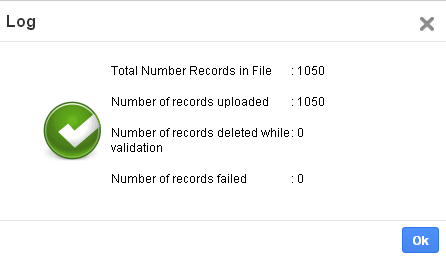


Use the azcopy env to check the current value of this variable. In a command prompt use:: set AZCOPY_JOB_PLAN_LOCATION=

PowerShell: $env:AZCOPY_JOB_PLAN_LOCATION="" When you resume a job, AzCopy will attempt to transfer all of the files that are listed in the plan file which weren't already transferred. The plan file lists all the files that were identified for processing when the job was first created. When you resume a job, AzCopy looks at the job plan file.
#GET COPY LOG DONE SUCCESS WINDOWS#
If you're using a Windows Command Shell (cmd.exe), enclose path arguments with double quotes ("") instead of single quotes (''). Use single quotes in all command shells except for the Windows Command Shell (cmd.exe). So instead of looking at the first error in the file, look for the errors that are near UPLOADFAILED, COPYFAILED, or DOWNLOADFAILED.Įnclose path arguments such as the SAS token with single quotes (''). The first error that you see might be something harmless that was successfully retried. For errors such as network errors, timeouts and Server Busy errors, AzCopy will retry up to 20 times and usually the retry process succeeds. The relevant error isn't necessarily the first error that appears in the file.
#GET COPY LOG DONE SUCCESS FULL#
The logs will contain the status of failure ( UPLOADFAILED, COPYFAILED, and DOWNLOADFAILED), the full path, and the reason of the failure.īy default, the log and plan files are located in the %USERPROFILE%\.azcopy directory on Windows or $HOME$\.azcopy directory on Mac and Linux, but you can change that location. You can use these logs to investigate and troubleshoot any potential problems.

Log and plan filesĪzCopy creates log and plan files for every job. If you need to use a previous version of AzCopy, see Use the previous version of AzCopy. This article applies to AzCopy V10 as is this is the currently supported version of AzCopy. With a 0 timeout, the notification will only be dismissed by the user or by pressing the button again.If you're looking for content to help you get started with AzCopy, see Get started with AzCopy. Now each time the button is clicked, the message Hello, World is displayed to the user as success. Change the second argument in our formula: Notify( "Hello, World", NotificationType.Success, 0 ) It will dismiss automatically in 4 seconds (4,000 milliseconds) if the user does not dismiss it or press the button again.Ĭhange the type of message to indicate success. Now each time the button is clicked, the message Hello, World is displayed to the user as a warning. Change the second argument in our formula: Notify( "Hello, World", NotificationType.Warning, 4000 ) It will dismiss automatically in 10 seconds (default timeout) if the user does not dismiss it or press the button again.Ĭhange the type of message to indicate a warning. Now each time the button is clicked, the message Hello, World is displayed to the user as an error. Add a second argument to our formula: Notify( "Hello, World", NotificationType.Error ) It will dismiss automatically in 10 seconds (default timeout) if the user does not dismiss it or press the button again.Ĭhange the type of message to indicate an error. Set the OnSelect property of the Button to the formula: Notify( "Hello, World" )Įach time the button is clicked, the message Hello, World is displayed to the user as informational. The notification will be displayed indefinitely with a Timeout of 0. The default is 10 seconds (or 10,000 milliseconds). Number of milliseconds to wait before automatically dismissing the notification. The default is NotificationType.Information. Type of the message to display from the table above. Note: This function was previously named ShowError when it could only display error messages. For more information see Send a notification in Power Apps. Power Apps can also send push notifications using an entirely different mechanism from Notify. Notify can be paired with the IfError function to detect and report errors with a custom error message. Notify can only be used in behavior formulas. Messages are shown both when authoring your app and when end users are using your app. The character limit for Notify function is 500 characters.


 0 kommentar(er)
0 kommentar(er)
